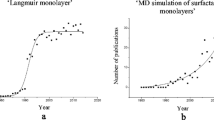Abstract
In some works on the lattice Monte Carlo simulation of amphiphilic systems additional peaks in the cluster size distribution has been interpreted as a clue for the phase or shape transition of micellar aggregates. On the other hand, some other works showed that the additional peaks are a result of finite size of the lattice box. In this paper using calculating energy-auto-correlation function and statistical error in correlated data, it is shown that how these apparently contradictory results are the same. To do this, we have simulated a pure system containing amphiphile and water molecules. A simple model of potential containing the main feature for these systems (the hydrophobicity of surfactant molecules) that cause the aggregates to be formed is considered to avoid any synthetic results due to additional non-real parameters. To relax the initial configuration faster, configurational bias Monte Carlo move is used in addition to reptation move. Periodic boundary condition and self-avoiding walks are used as former published works in this field. It is shown that the additional peaks is a result of the statistical errors for averaged cluster size distribution and can not be interpreted as a clue for shape or phase transition.
Similar content being viewed by others
References
Frenkel D and Smit B (1996). Understanding molecular simulation: from algorithms to applications. Academic, London
Allen MP and Tildesley DJ (1987). Computer simulation of liquids. Clarendon, Oxford
Binder K (1992) In: Marcel JB (Ed) Computational modeling of polymers. Dekker, New York
Doye JPK, Sear RP and Frenkel D (1998). J Chem Phys 108: 2134
Bohbot Y, Ben-Shaul A, Granek R and Gelbart WM (1995). J Chem Phys 103: 8764
Mackie AD, Onur K and Panagiotopoulos AZ (1996). J Chem Phys 104: 3718
Larson RG, Scriven LE and Davis T (1985). J Chem Phys 83: 2411
Larson RG (1989). J Chem Phys 91: 2479
Behjatmanesh-Ardakani R (2005). J Chem Phys 122: 204903
Bhattacharya A and Mahanti SD (2001). J Phys C 13: L861
Nelson PH, Rutledge GC and Hatton TA (1997). J Chem Phys 107: 10777
Bhattacharya A, Mahanti SD and Chakrabati A (1998). J Chem Phys 108: 10281
Bourov GK and Bhattacharya A (2003). J Chem Phys 119: 9219
Groot RD and Warren PB (1997). J Chem Phys 107: 4423
Bourov GK and Bhattacharya A (2005). J Chem Phys 122: 044702
Bernardes AT, Henriques VB and Bisch PM (1994). J Chem Phys 101: 645
Nelson PH (1998) Simulation of self-assembled polymer and surfactant systems. Ph.D. Thesis Massachusetts Institute of Technology
Talsania SK, Rodriguez-Guadarrama LA, Mohanty KK and Rajagopalan R (1998). Langmuir 14: 2684
Lisal M, Hall CK, Gubbins KE and Panagiotopoulos AZ (2002). J Chem Phys 116: 1171
Talsania SK, Wang Y, Rajagopalan R and Mohanty KK (1997). J Colloid Interfac Sci 190: 92
Gharibi H, Behjatmanesh-Ardakani R, Hashemianzadeh SM, Mousavi-Khoshdel SM, Javadian S and Sohrabi B (2006). Theor Chem Acc 115: 1
Tanford C (1973). The hydrophobic effects. Wiley, New York
Siepmann JI and Frenkel D (1992). Mol Phys 75: 59
Metropolis N, Rosenbluth AW, Rosenbluth MN, Teller AH and Teller E (1953). J Chem Phys 21: 1087
Flyvbjerg H and Petersen HG (1989). J Chem Phys 91: 461
Gharibi H, Behjatmanesh-Ardakani R, Hashemianzadeh M and Mousavi-Khoshdel M (2006). J Phys Chem B 110: 13547
Gharibi H, Behjatmanesh-Ardakani R, Hashemianzadeh SM, Sohrabi B and Javadian S (2006). Bull Chem Soc Jpn 79: 1355
Ben-Naim A and Stillinger FH (1980). J Phys Chem 84: 2872
Goldstein RE (1986). J Chem Phys 84: 3367
Ruckenstein E and Nagarajan R (1975). J Phys Chem 79: 2622
Author information
Authors and Affiliations
Corresponding author
Rights and permissions
About this article
Cite this article
Behjatmanesh-Ardakani, R. Additional peaks in the cluster size distribution of amphiphile + water systems: a clue for shape/phase transition or statistical uncertainty. Theor Chem Account 118, 799–805 (2007). https://doi.org/10.1007/s00214-007-0327-1
Received:
Accepted:
Published:
Issue Date:
DOI: https://doi.org/10.1007/s00214-007-0327-1



